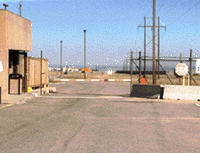|
|
Stewardship Issues at DOE Sites:
Regional
Impacts of Nuclear Weapon Facilities
Past, Present and Future

CRESP research has focused on the analysis of
the impacts of future use alternatives at major
Department of Energy sites. The following selected
researcher reports and publications illustrate CRESP's
work in this area.
The reports have been selected to highlight three
areas of CRESP research at Department of Energy sites: Future Land Use, Economic Considerations,
and Biomonitoring
for Stewardship. Within each topic papers are
arranged according to individual sites and those applying
to all Nuclear weapons complex.
Reports that are not available in full text may be
requested from the CRESP library at lbliss@eohsi.rutgers.edu
or by phone at (732)235-9604.
Future
Land Use
Understanding both how the Department of Energy views
the future uses of their lands, and how various tribal
nations and other stakeholders view future land use, is
critical to decisions about clean-up. These
understandings in turn affect stewardship on the DOE
lands, whether they remain under DOE or not. CRESP has
been involved in developing tools to understand
stakeholder views of future land use, and in examining
the future use preferences of many different groups, from
local land managers and planners to recreationists.
CRESP Publication/Report Titles
Listed by Location
|
|
|
| ACROSS ALL DOE COMPLEX: |
Abstract |
Full Text |
| Bombs and butterflies: A case study of the
challenge of post cold war environmental planning
and management for United States' nuclear weapons
sites * (Link to journal for full text) |

|

|
| Local Impacts of U.S. Nuclear Weapons
Facilities: A Survey of Planners. CRESP
Researcher Report |
|
 |
| Land Use Allocation Optimization Models
Applied to Future Use at the U.S. D.O.E.'s Major
Nuclear Weapons Sites. CRESP Researcher Report |
|
 |
| ROCKY FLATS: |
|
|
| Cleaning it Up and Closing it Down: Land Use
Issues at Rocky Flats* |

|
 |
| SAVANNAH RIVER: |
|
|
| Attitudes and perceptions about ecological
resources and hazards of people living around the
Savannah River Site* |

|
|
| Environmental attitudes and perceptions of
future land use at the Savannah River Site: Are
there racial differences?* |

|
|
| Gender Differences in Recreational use,
environmental attitudes and perceptions of future
land use at Savannah River Site.* |

|
|
| Placing Future Land Use Planning in a
Regional Context: The Case of the Savannah River
Site* |
|
 |
| Recreation and risk: Potential Exposure* |

|
|
| Risk perception, federal spending, and the
Savannah River Site: attitudes of hunters and
fishermen* |

|
|
| IDAHO NATIONAL ENGINEERING
AND ENVIRONMENTAL LABORATORY |
|
|
| Recreation, consumption of wild game, risk,
and the Department of Energy sites: perceptions
of people attending the Lewiston (Idaho) Roundup* |

|
|
| American Indians, Hunting and Fishing Rates,
Risk and the Idaho National Engineering and
Environmental Laboratory* |

|
|
*Peer
Reviewed Publication
Economic
Considerations
The facilities that make up our nation's nuclear weapons complex have
employed hundreds of thousands of workers over the past five decades.
In some regions, these employees represent a large percentage of the
total workforce and DOE spending is a significant portion of the
economy. In the Post-Cold War era, most production activities have
ceased, and facilities are either closing down or taking on new
missions. CRESP research has examined the current and future impacts of
these changes on the regional economies around the DOE's major sites.
CRESP Publication/Report Titles
Listed by Location
|
|
|
| ACROSS ALL DOE COMPLEX: |
Abstract |
Full Text |
| A Modeling Framework for Analyzing the
Economic Impacts of the Department of Energy's
Environmental Management Program. CRESP
Researcher Report |

|
|
| Economic Fallout* (Link to journal for full text) |
|

|
| Economic Impact of Accelerated Cleanup on
Regions Surrounding the U.S. DOE's Major Nuclear
Weapons Sites. CRESP Researcher Report. |

|

|
| Impact of Providing Off-Site Economic
Development Funds to Dependent Regions
Surrounding the U.S. DOE's Major Nuclear Weapons
Sites. CRESP Researcher Report |
|

|
| Rebounding From the Loss of a Major Employer:
DOE Regions in Idaho, South Carolina, Georgia and
Washington. CRESP Researcher Report |
|

|
| Regional Economic Benefits of Environmental
Management at the U.S. Department of
Energy’s Major Nuclear Weapons Sites*
|

|
|
| SAVANNAH RIVER: |
|
|
| Downsizing U.S. Department of Energy
Facilites: Evaluating Alternatives for the Region
Surrounding the Savannah River Nuclear Weapons
Site Region. CRESP Researcher Report |
|

|
*Peer
Reviewed Publication
Biomonitoring
for Stewardship
For wise decisions about both cleanup and future land
use, it is essential to have viable biomonitoring plans
to evaluate the risk from contamination, physical
disruptions, and other perturbations on DOE lands.
CRESP researchers have focused on biomonitoring
of the physical environment, and the biological
environment.
CRESP Publication/Report Titles
Listed by Location
|
|
|
| ACROSS ALL DOE COMPLEX: |
Abstract |
Full Text |
| Ecological risk assessment at the Department
of Energy: An evolving process* |

|
|
| Environmental monitoring on Department of
Energy lands: The need for a holistic plan* |

|
|
| Methods and approaches to evaluating
susceptibility of ecological systems to hazardous
chemicals* |

|
|
*Peer
Reviewed Publication
HOME// MISSION// SUMMARY OF WORK// CONSORTIUM MEMBERS//
TASK GROUPS// STAFF DIRECTORY// LIBRARY// PUBLICATIONS AND
DOCUMENTS// INTERNET LINKS// CURRENT RESEARCH AND NEWS//
|